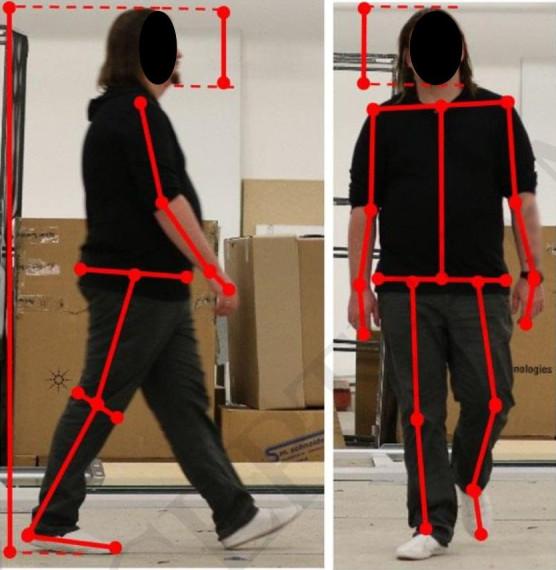
Left: a person walking, seen from the side. Right: the same person walking, seen from the front. Red lines mark some of the body features used for gait recognition.
Gait recognition (also known as gait analysis) is the analysis of the manner or style in which people move for the purpose of matching one manner or style to another.
When you move, you naturally adopt a relatively unique gait that depends on several factors, including:
- Intrinsic factors: how you learned to walk, your anatomy and physiology, and any injuries or pathologies you may have.
- Extrinsic factors: your clothing and the terrain on which you move (flat or not, with or without obstacles…)
An adversary watching you move can locate, measure, and categorize your body features (position of your ankles, knees, hips…) at various stages of movement and compare them to the body features of another moving person. This comparison can allow the adversary to determine whether or not you could be that other person, but it usually doesn't allow the adversary to determine with certainty that you are that other person. This comparison is usually done by humans, sometimes assisted by specialized software.
Gait recognition is typically done by comparing two sets of video footage. The first set shows a first person moving, and the second set shows a second person moving. The goal of the comparison is to determine whether or not the first and second person could be the same person. The strength of the recognition, that is, the confidence in the determination that the first person could be the second person or not, depends on several factors, including:
- The quality and frame rate of the footage.
- The lighting in the scene.
- Whether the two people are sufficiently close to the camera, fully visible, taking several steps, and wearing clothing that doesn't excessively hide their gait.
- Whether the two people have a generic or unique gait. For example, a person with a limp has a rather unique gait.
- Whether the two people are seen from similar angles performing the same type of movement (e.g. either walking or running).
The following is a typical scenario in which an adversary uses gait recognition:
- A person is captured by CCTV carrying out an action. They are not recognizable because they are dressed anonymously. The adversary obtains the CCTV footage.
- Based on other evidence, the adversary suspects someone of having carried out the action. They obtain footage of this suspect moving, either through CCTV near their home, CCTV while they are in custody, or a covert video surveillance device.
- The adversary compares the person's gait in the first footage to the suspect's gait in the second footage to determine whether or not they could be the same person, and the confidence in that determination.
See Forensic Gait Analysis: Principles and Practice ?This is a link to the Surveillance Archive. Use Tor Browser to access it. for a comprehensive overview of gait recognition.
Used in tactics: Incrimination
Mitigations
| Name | Description |
|---|---|
| Anonymous dress | You can wear baggy clothing to conceal your gait. |
| Biometric concealment | You can wear baggy clothing that hides your body shape, use an umbrella or other concealing objects, or drastically change your walking style by adopting a “funny walk”. |
| Careful action planning | An adversary can use gait recognition to analyze your gait on CCTV footage at or near an action site. To mitigate this, you can carefully plan the action so you avoid moving with your usual gait near a camera. |
Used in repressive operations
| Name | Description |
|---|---|
| Repression of the attack on Clarín's headquarters | One of the defendants was identified because their gait was considered compatible with that of a suspect visible in CCTV footage near the attack site.[1] |
| Bialystok | The main evidence against the person accused of an explosive attack on a police station was a comparison of his gait and the color of his coat with the corresponding characteristics of a person recorded by the surveillance cameras of the police station.[2] |
| Scintilla | Two of the people were accused of arson because their gait and body shapes were considered compatible with people recorded by video surveillance cameras placing a canister of flammable liquid in front of an Italian post office.[3] |
| Operation 8 | One person was identified in footage of the “training camps” based on their height, gait, and skin color.[4] |

 English
English